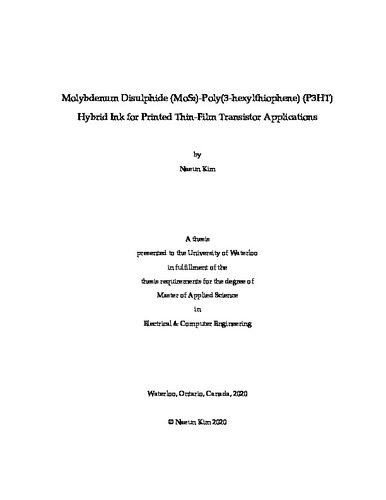| dc.contributor.author | Kim, Naeun | |
| dc.date.accessioned | 2020-02-14 14:45:09 (GMT) | |
| dc.date.available | 2020-02-14 14:45:09 (GMT) | |
| dc.date.issued | 2020-02-14 | |
| dc.date.submitted | 2020-02-06 | |
| dc.identifier.uri | http://hdl.handle.net/10012/15638 | |
| dc.description.abstract | Organic Thin-Film Transistors (OTFTs) based on Poly(3-hexylthiophene) (P3HT)-Molybdenum Disulphide (MoS₂) composite films as an active layer were prepared via inkjet printing. There have been many attempts to incorporate inorganic materials into organic semiconductors, however, the inkjet-printed MoS₂-P3HT hybrid ink for Thin-Film Transistor (TFT) applications is shown here for the first time. The P3HT-MoS₂ hybrid TFTs exhibited higher carrier mobility than the baseline TFT with pure P3HT. We assume this is attributed to the molecular ordering of P3HT improved with the existence of MoS₂ nanoparticles in the film and also the high hole carrier mobility of MoS₂ could act as a conducting bridge.
In this research, the first step was to improve overall TFT performance by optimizing the OTFT process conditions. Various factors were examined including surface treatment, solution preparation, and post-processing to change the crystallization of polymer film through different process conditions. It was shown that the Self-Assembled Monolayer (SAM) treatment could give preferred molecular orientation to the film; the selection of organic solvents is important because their boiling point affects film formation; the film thickness and post-processing conditions also affect the mobility as well as the off-current.
Meanwhile, the MoS₂-P3HT hybrid ink was formulated with simple steps. This ink was prepared for inkjet printing. The jetting and printing parameters are precisely controlled to enable the printing of a hybrid channel array on top of pre-patterned electrodes. Especially, the ink should be compatible with selected nozzles, otherwise, the nozzle can be blocked or the misprint may cause device failure. The TFTs with a MoS₂-P3HT hybrid channel were successfully fabricated via inkjet printing. With the incorporation of MoS₂ nanoparticles, the hybrid TFTs exhibit mobility as high as 2.35×10⁻² cm²/V-s which is more than two times higher than the P3HT-only TFTs while maintaining the on/off ratios and threshold voltages. | en |
| dc.language.iso | en | en |
| dc.publisher | University of Waterloo | en |
| dc.subject.lcsh | Thin film transistors | en |
| dc.subject.lcsh | Organic thin films | en |
| dc.title | Molybdenum Disulphide (MoS₂)-Poly(3-hexylthiophene) (P3HT) Hybrid Ink for Printed Thin-Film Transistor Applications | en |
| dc.type | Master Thesis | en |
| dc.pending | false | |
| uws-etd.degree.department | Electrical and Computer Engineering | en |
| uws-etd.degree.discipline | Electrical and Computer Engineering | en |
| uws-etd.degree.grantor | University of Waterloo | en |
| uws-etd.degree | Master of Applied Science | en |
| uws.contributor.advisor | Wong, William S. | |
| uws.contributor.affiliation1 | Faculty of Engineering | en |
| uws.published.city | Waterloo | en |
| uws.published.country | Canada | en |
| uws.published.province | Ontario | en |
| uws.typeOfResource | Text | en |
| uws.peerReviewStatus | Unreviewed | en |
| uws.scholarLevel | Graduate | en |

